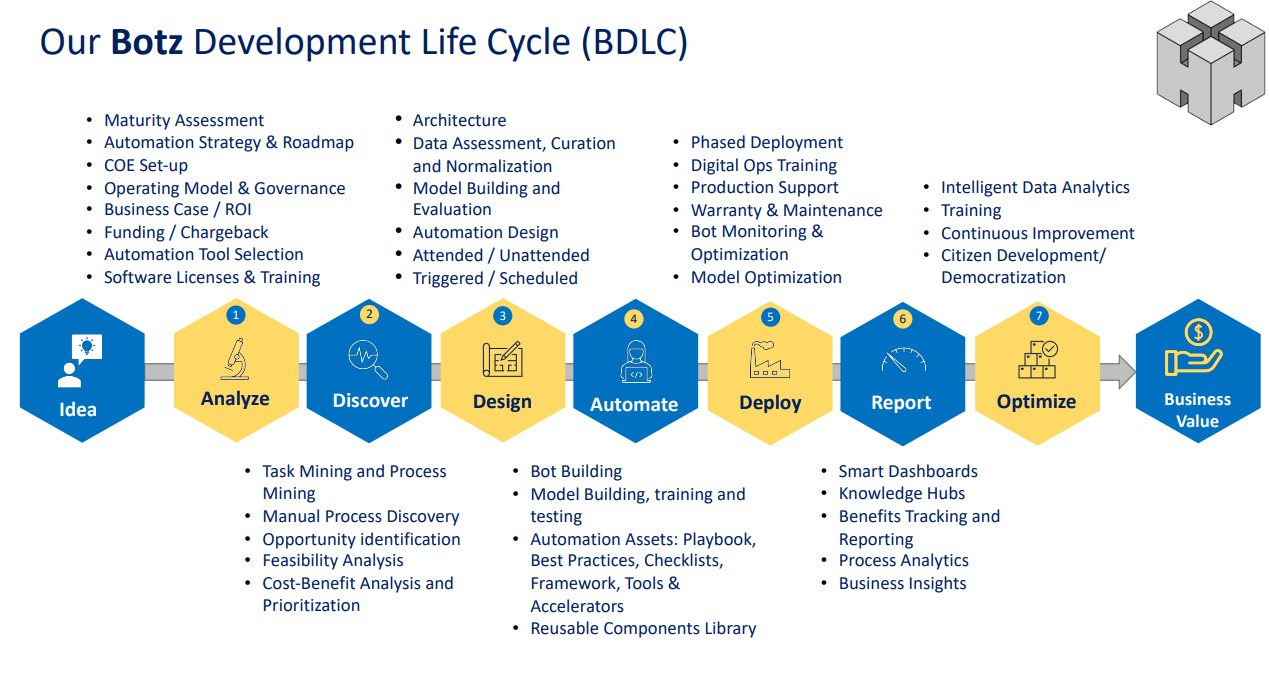

While there is wide acceptance of the fact that Robotic Process Automation (RPA) and process mining augment each other, many companies have not been successful in putting both technologies to good use in their businesses very effectively. Here are a few suggestions to begin using both technologies to boost the outcome of your process excellence and automation initiative.
Companies struggle to scale their automation program at an enterprise level for various reasons. Keeping the organizational dynamics aside, many businesses find it overwhelming to analyze enterprise-wide processes and identify the right candidates for automation.
The next challenge firms encounter comes with understanding the processes and estimating the associated benefits and costs to achieve the desired ROI by prioritizing high-value, low-effort opportunities. Studies have shown that 40-50% of the Bot Development Lifecycle is spent on identifying, prioritizing, and documenting the processes, with the rest of the time split among bot design, coding, review, unit testing, integrated testing, UAT, pre-deployment configuration, and deployment activities.
Process mining gives a business a complete picture of their state of processes as-is, which in turn can be used by our RPA team to turn into actionable automation. Process mining helps you highlight the best automation candidates, enabling you to determine the extent to which RPA can be implemented in the legacy processes and systems.
RPA teams often find it challenging to obtain the necessary resources, time, attention, and information from the business process owners to document processes to the extent required for bot development. Due to conflicting priorities and changing business dynamics, many automation efforts are put on hold or canceled as business process owners become unavailable. But process mining software provides detailed process maps that can act as a guide for bot development. Process mining helps reduce discovery time and drastically reduces the time commitment from business process owners.
In addition, process mining tools often provide a capability of executing business-rule driven automated actions, but they are generally limited in terms of type of actions such as sending emails, pushing a report, or alerting business users for further actions. Using these process mining tool actions to kick off RPA bots gives you unlimited power of end-to-end automation.
Also, while RPA tools allow you to measure post-automation indicators of accuracy and productivity, process mining software provide pre-automation historical values, as well as the upstream and downstream impact of automation.
RPA bots generate detailed logs of each data element that they touch or use in decision making. Process mining software can benefit from such detailed logs to provide greater visibility into the process performance. Thus, these technologies truly complement each other to further your business goals. A recent Gartner report on Complemented RPA (CoRPA) even mentioned that:“A significantly improved version of the current RPA development tool known as the process recorder, that has UI interaction record and playback capabilities, will dynamically generate the RPA script based on lessons from process mining and process discovery.”
Recognizing the multiplier effect of combining these two powerful concepts, one major RPA tool provider, UiPath, acquired process miner ProcessGold in 2019. Similarly, Automation Anywhere purchased FortressIQ in 2021 for process discovery. Major process mining tool providers, like Celonis and Minit, also boast their capabilities to augment the power of automation. It is becoming evident that RPA projects are more likely to succeed with the addition of process mining.
---------------------------------------------------------------------------------------------------
Robotic process automation (or RPA) is a form of business process automation technology based on metaphorical software robots (bots) or digital workers. RPA systems uses application's graphical user interface (GUI) to perform manual tasks directly in the GUI.
Process mining is a family of techniques in the field of process management that support the analysis of business processes based on event logs. During process mining, specialized data mining algorithms are applied to event log data to identify trends, patterns and details contained in event logs recorded by an information system. Process mining aims to improve process efficiency and understanding of processes. The term Process Mining is used in a broader setting to refer not only to techniques for discovering process models, but also techniques for business process conformance and performance analysis based on event logs.
While discussing the Business Process Automation (Intelligent or Robotic), often the terms such as Process Discovery, Process Assessment, Opportunity Identification, Task Mining and Process Mining, are used, and many times they are used interchangeably. It always helps to have a clear idea of what is what so that you can effectively utilize the ones that most applicable in your business situation, to understand your opportunities, and to resolve your business problems.
The goal of Process Discovery is to make explicit an existing process to make it known, understood, and shared by everyone involved. Process Discovery serves to clarify and document the current situation (often called the as-is process).
Process Assessment is about assessing or analyzing this as-is process for efficiency and effectiveness potential. Efficiency assessment helps us understand how much waste (of time and resources) exist, and effectiveness measures its ability to consistently meet the business needs. The goal of this exercise could be with an intention to improve the process i.e. optimizing it or making it ‘lean’ by removing the waste (process optimization) or standardizing it (process standardization), automating it (process automation), or in some cases, eliminating it (process elimination). Hence, it’s associated with a term Opportunity Identification, which is identifying an opportunity to improve, enhance, standardize, optimize, or automate the process. They all finally help you deliver business value either through direct financial gain or increase in customer satisfaction or reduction in operational risk and compliance failures.
Process mining is a technique designed to discover, monitor, and improve real processes (i.e., not assumed processes) by extracting readily available knowledge from the event logs of information systems. Thus, process mining, by definition, usually uses a process mining tool or a SaaS platform. So, many define process mining as the technology that helps to uncover entire business processes in your organization.
Some of the Process Mining tool/platform/technology providers like to claim that there are three main classes of process mining techniques: process discovery, conformance checking (adherence to standard process or intended process), and process enhancement. With new developments in Artificial Intelligence, some of the process mining tools also make recommendations for process improvement or incident resolution steps.
While Process Mining is a powerful tool for gaining insight into enterprise level processes, Task Mining operates at a desktop level to discover and analyze the tasks that users perform, usually, as a part of enterprise level processes. Task Mining is the technology that allows businesses to capture user interaction (or desktop) data, so they can analyze how their people are getting work done, and how they can do it even better. Task mining discovers the tasks that complete the individual steps of the end-to-end business process.

10619 Saluda Ave.
Glen Allen, VA 23060. USA
(804) 893-0839
Copyright © hyper-botz.com -2022